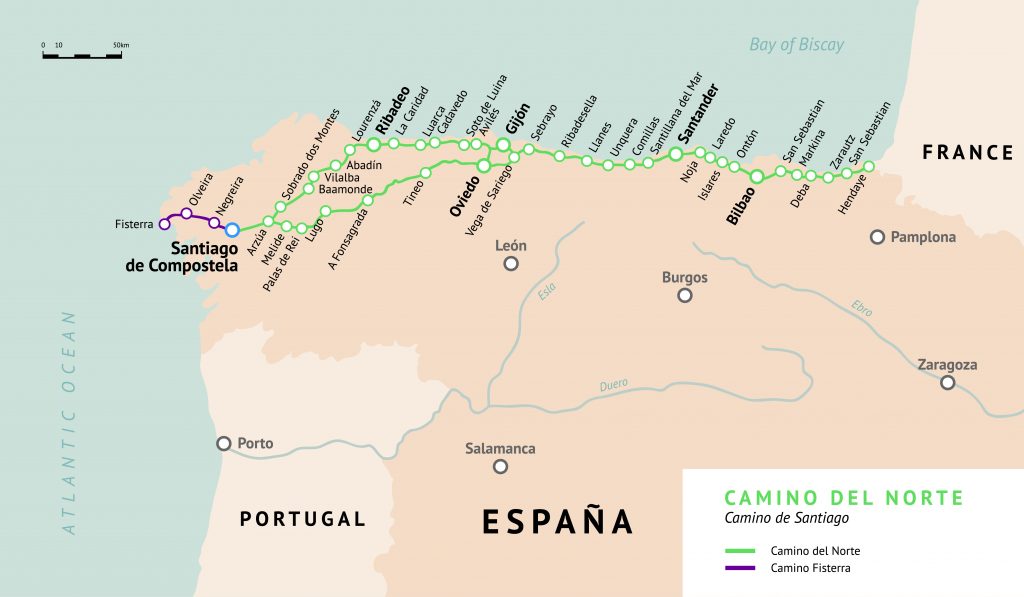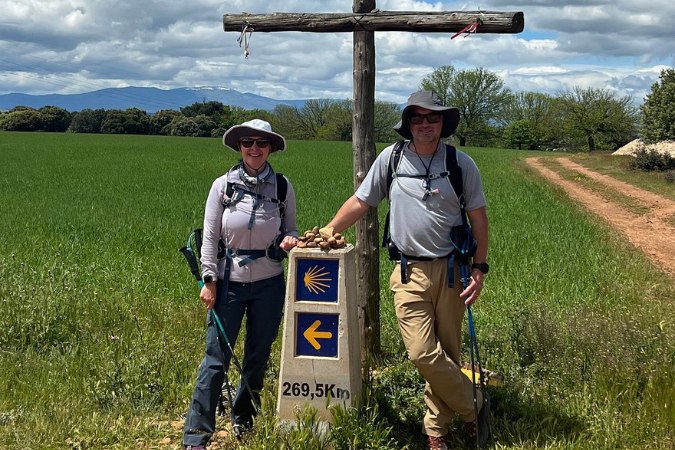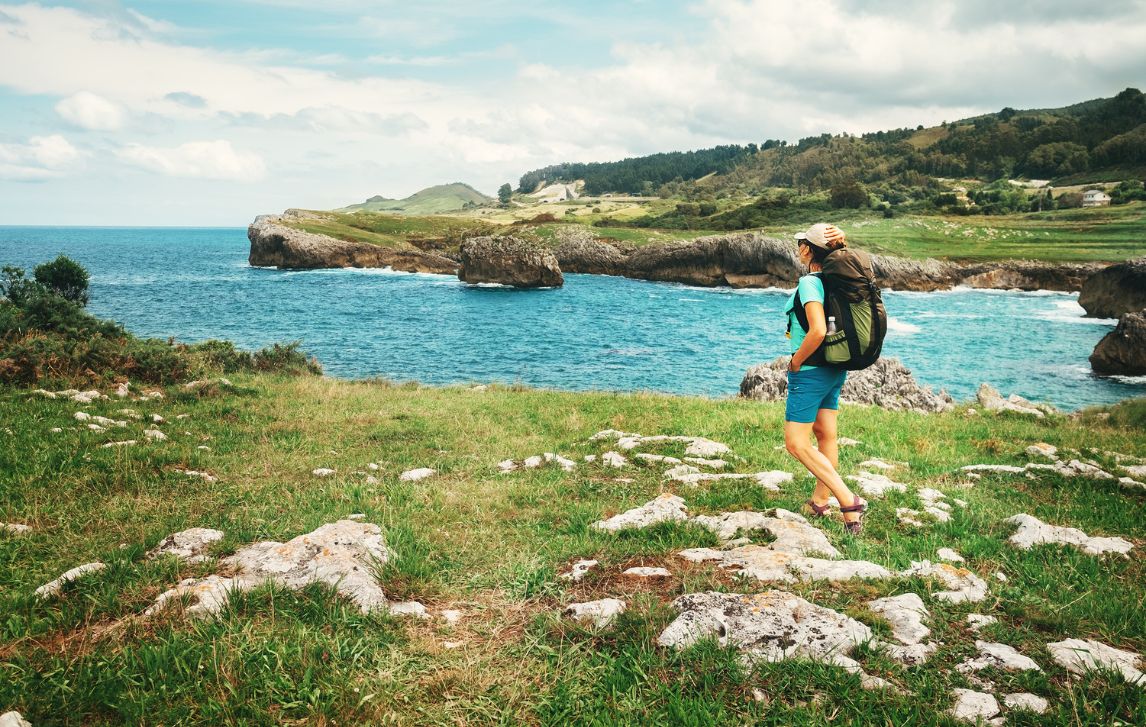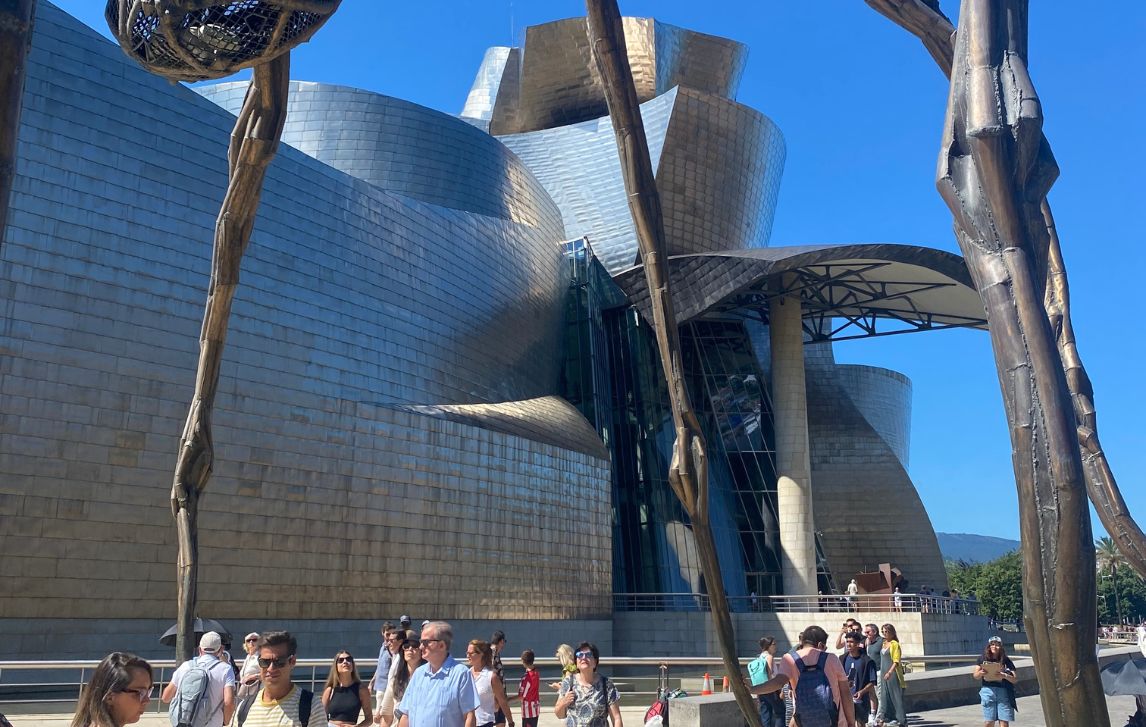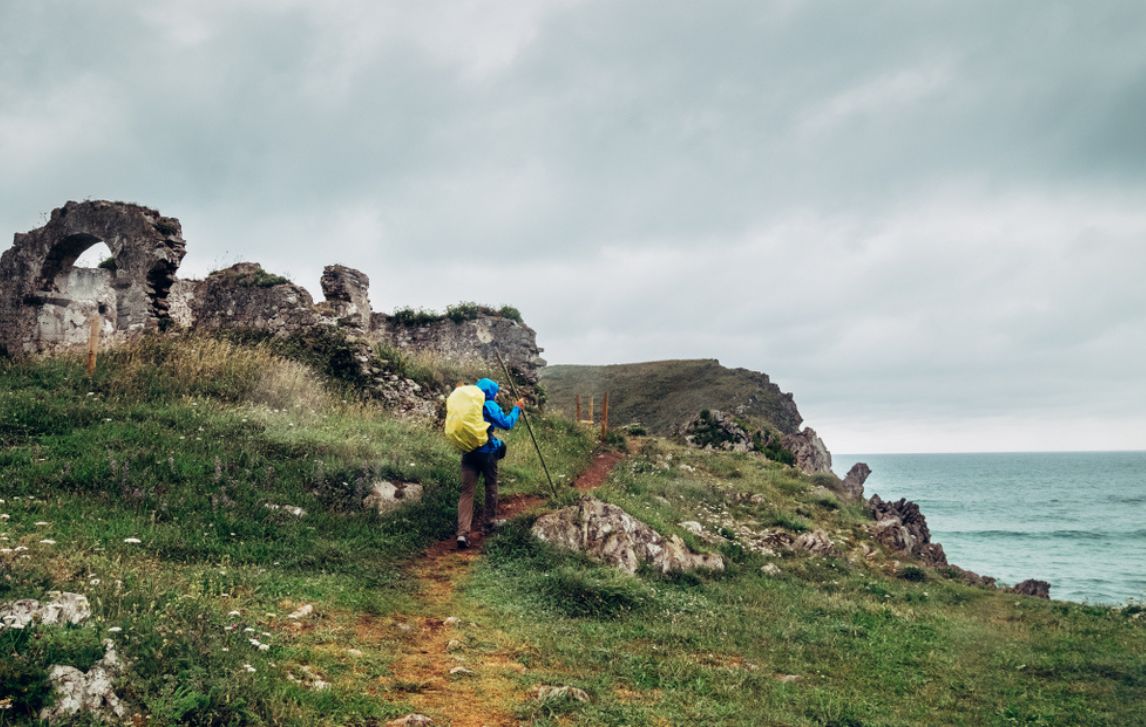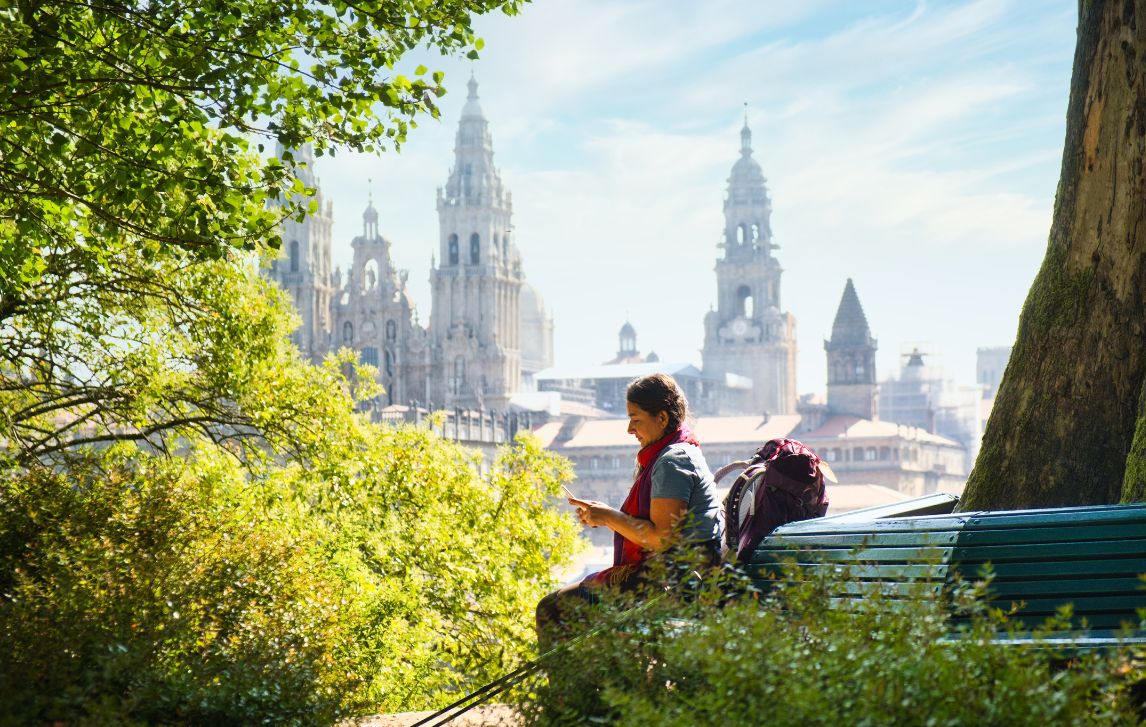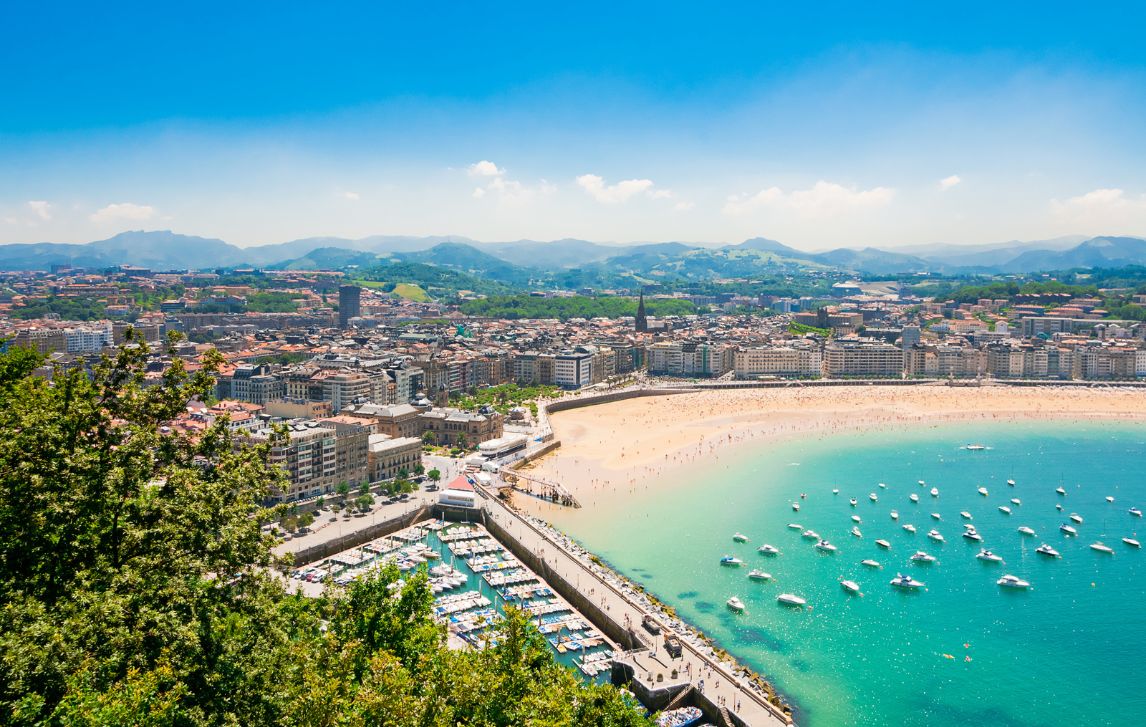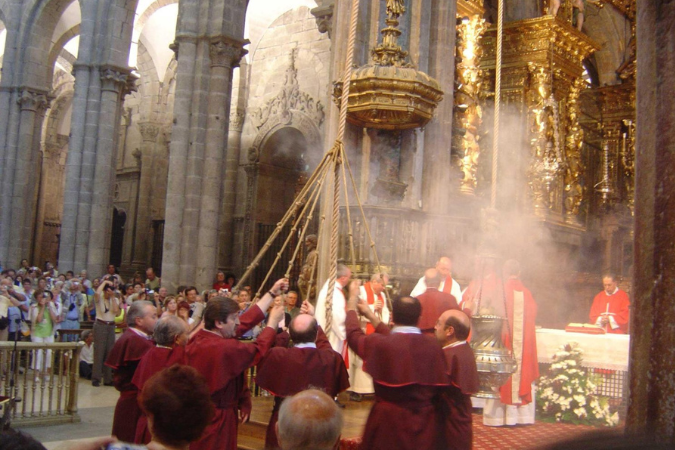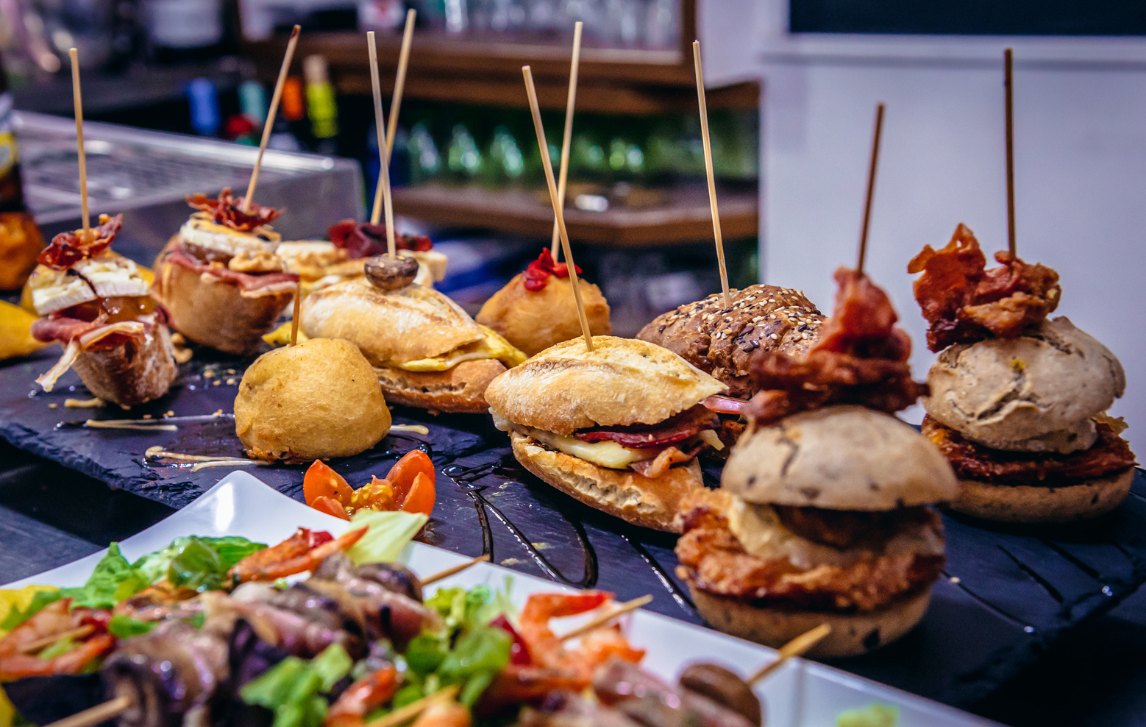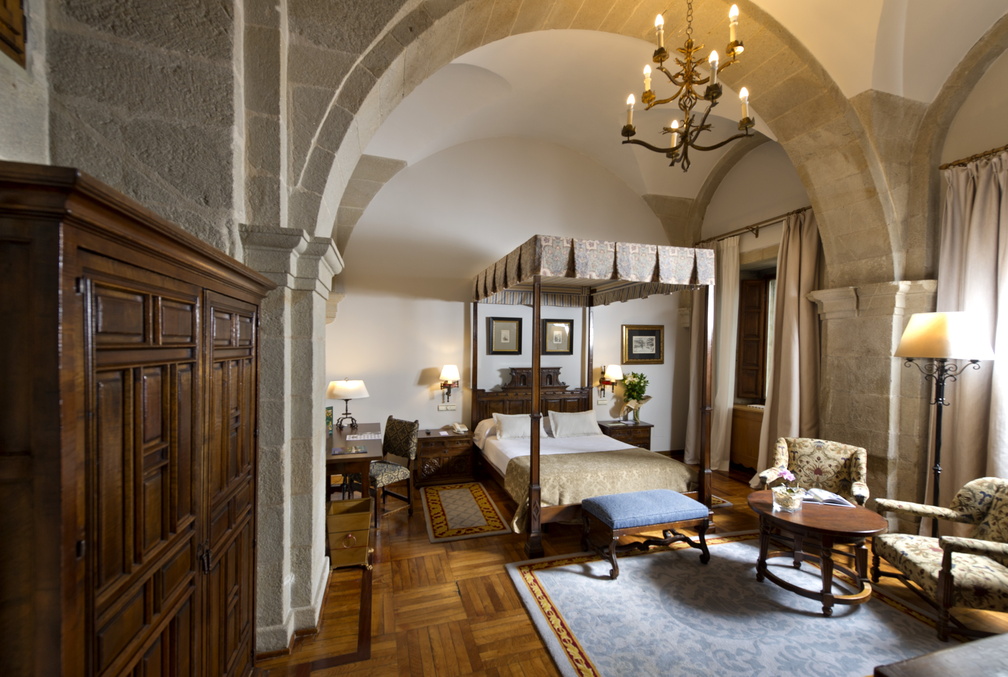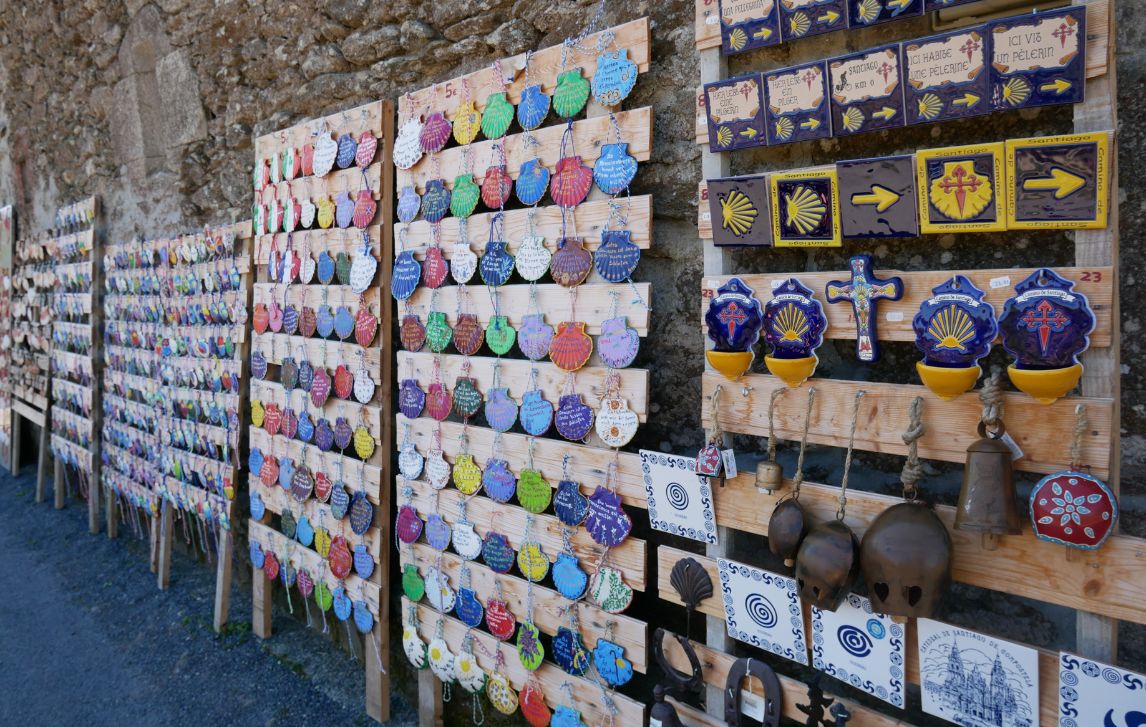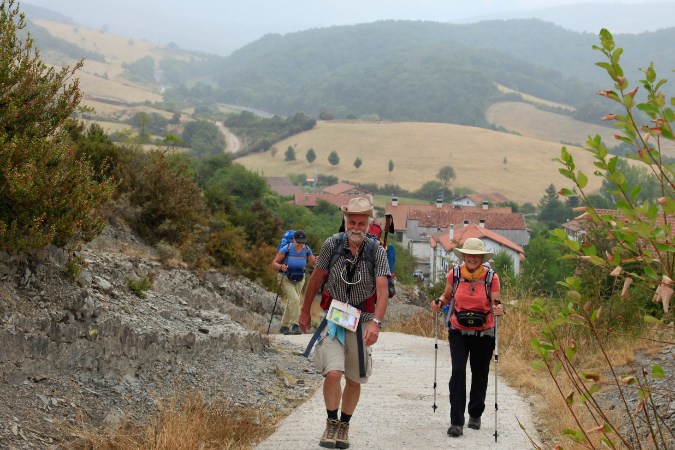17 Jun 25
Camino Francés vs Camino del Norte: Which Route Should You Choose?
Planning your Camino is the start of an unforgettable journey – and it’s one of the most exciting parts! But with so many route options, it can also feel a little overwhelming. As the Camino Francés grows in popularity, more routes to Santiago are being explored. If you’re torn between the Camino Francés and the Camino del Norte, you’re not alone.
This guide will help make your decision easier. We’ll start with a brief overview of each route, then walk you through some of the most frequently asked questions to help match the right trail to your goals and fitness level.
If after reading this you’re still unsure? No problem – our Camino experts are just a call or email away. Sometimes, a quick chat is all it takes to find the perfect fit.
Let’s dive in and discover which route is best for you!
| Camino Francés | Camino del Norte | |
| Overview | The Camino Francés is one of the oldest pilgrimage routes, with over 1,200 years of history and UNESCO World Heritage status. It passes through major northern Spanish cities like Pamplona, Burgos, and León. Known for its well-marked paths and rich cultural heritage, it attracts pilgrims from all over the world who follow this traditional route to Santiago. The most popular Camino route due to its accessibility and abundance of services making it a favourite for both first-timers and experienced walkers alike. | The Camino del Norte is a stunning coastal pilgrimage route that stretches from Irún to Santiago de Compostela, passing through the Basque Country, Cantabria, Asturias, and Galicia. Known for its dramatic scenery and varied terrain – cliffs, forests, and beaches – it offers a more physically demanding and less crowded alternative to the Camino Francés. With fewer pilgrims, the route provides a more peaceful, introspective experience. |
| Starts | Saint-Jean-Pied-de-Port, France | Irún, Spain |
| Distance | 780km | 825km |
| Popularity | More than 230,00 pilgrims each year | ~21,000 pilgrims each year |
| Cities | Pamplona, Logroño, Burgos, León, Sarria | San Sebastián, Bilbao, Santander, Gijón, Ribadeo |
| Difficulty | Moderate | Moderate to challenging |

Now that we’ve covered the basics, let’s dig a little deeper….
How long does it take to complete each route?
Typically, the Camino Francés is shorter in total length and usually takes about 4 to 6 weeks to complete. Our Full-length Camino Francés itinerary spans 41 days, including rest days in major cities like Pamplona, Burgos, León, Sarria, and Santiago. Daily walking distances average between 20–25 km, with some days shorter or longer depending on the stage.
The Camino del Norte is slightly longer and more challenging, often requiring 5 to 7 weeks to finish. Our Full-length Camino del Norte itinerary covers 43 days, with rest days in key cities such as Bilbao, Santander, Llanes, Gijón, Ribadeo, and Santiago. Average daily distances range from 22–30 km, with some days shorter or longer depending on the stage.
A common request is to skip rest days to shorten their trip. While tempting, we strongly recommend keeping them. Rest days help with unexpected needs – like laundry or medical care – and give your body time to recover. Plus, these breaks are in the largest cities along the route, offering rich cultural experiences beyond just supply stops.
✨ Trip spotlight If you are short on time but want to experience the best of each route? Check out our Camino Highlights Trips on both the Camino Francés and Camino del Norte. These itineraries use local transport to focus on the most popular and scenic sections of the trail. Plus, all our independent itineraries are fully customisable – need to shorten your trip or add extra days? Just let us know!
What’s the main difference in scenery and terrain?
Both trails cover significant distances and cross multiple regions of Spain, each showcasing unique culture, cuisine, and history.
Camino Francés
This inland route spans about 790km and features varied terrain – rolling hills, farmlands, medieval villages, and famous wine regions like La Rioja. Walkers traverse shepherd’s mountain tracks, forest dirt paths, gravel trails, and roads. The route includes three significant mountain passes reaching up to 1,500m and crosses the vast, open Meseta plateau. Near towns and cities, the trail often follows paved roads and footpaths. The landscape softens into gentler, hillier terrain as you approach Galicia.
Notable cities en route: Pamplona, Logroño, Burgos, León, Sarria
Camino del Norte
This coastal route offers a rich variety of landscapes – from stunning coastal paths and lush forest trails to rolling countryside. The trail passes through fishing villages, rural settlements, bustling port towns, and vibrant cities, so hikers should be prepared for diverse conditions. Some sections are rugged, with uneven surfaces and compact dirt paths that can become slippery when wet. There are also stretches of road walking near major cities. It’s more physically demanding, featuring frequent steep ascents and descents, rugged terrain, and longer distances between amenities.
Notable cities en route: San Sebastián, Bilbao, Santander, Gijón, Ribadeo
💡 Good read Looking for more information on these trails and others? RAW Travel’s Destination Guide is an amazing resource – download your own copy here!
Which route is more social?
Many people imagine their Camino experience as an opportunity to meet fellow pilgrims from around the world, forming a “Camino family” and building lifelong connections. The Camino Francés is famous for this and definitely the more social of the two routes. With over 200,000 pilgrims each year, it’s perfect for those seeking community, conversation, and shared experiences. Solo hikers especially benefit, as it’s rare to walk alone for long – offering a comforting sense of connection throughout the journey.
In contrast, the Camino del Norte sees around 20,000 pilgrims annually. While its popularity is growing, it still provides a quieter, more solitary experience – ideal for those drawn to solitude, seeking time away from crowds for quiet reflection and personal space. Solo travellers should be prepared for stretches with few or no other pilgrims. The most popular section, from San Sebastián to Bilbao, offers the best chance to meet others but shouldn’t be expected.
✨ Trip spotlight Looking for a more social experience? Explore our self-guided group trips on the Camino Francés and Camino del Norte routes. Share the adventure with like-minded travellers – while still enjoying the freedom to explore at your own pace.
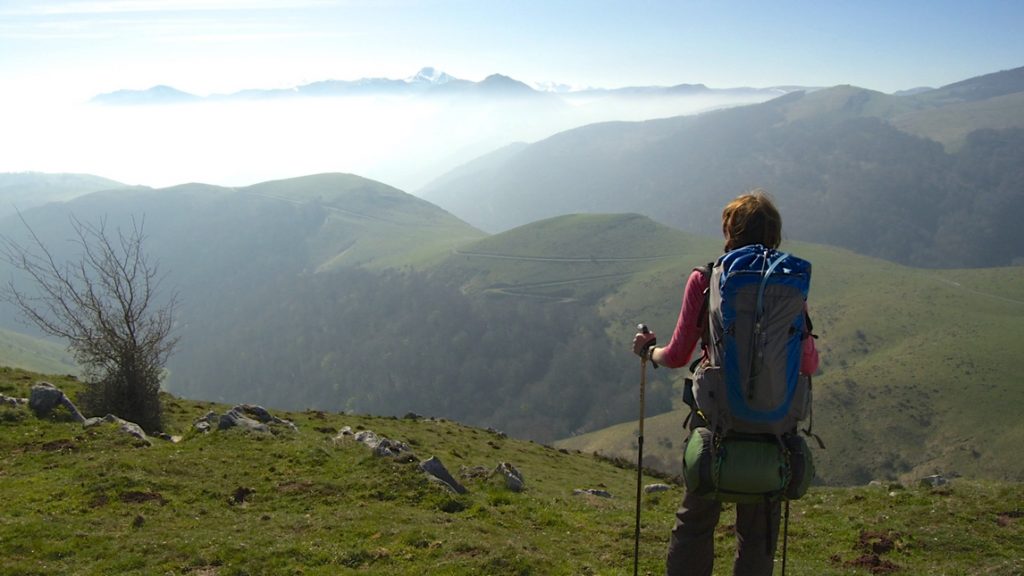 Which route has better infrastructure?
Which route has better infrastructure?
The Camino Francés is more developed, featuring a higher number of accommodations, services, and clear signage, which makes navigation easier and access to essentials more convenient. This extensive infrastructure is largely due to the high volume of pilgrims, encouraging local businesses such as restaurants, cafes, and albergues to set up along the route. With abundant pilgrim-focused facilities, the Francés is very accessible – ideal for first-time walkers who may need to utilise frequent local transfers, or customise their itinerary to suit specific walking distances and pace.
The Camino del Norte includes more remote stretches with fewer pilgrim-focused services. Accommodations between larger cities can be limited, resulting in more competition for spots. While signage is generally clear, some sections may require additional navigation due to multiple trail options – some more difficult and less well-marked than others. Walkers need to be well-prepared and adaptable, carrying enough supplies for isolated areas. Though rewarding, this route can be challenging for those new to this type of hiking, requiring advanced preparation. However, sections with more services and higher populations – such as San Sebastián to Bilbao – offer great entry points for beginners.
💡Preparation essentials Preparation is key on all Camino routes, but the Camino Francés offers more flexibility, while the Camino del Norte requires more advanced planning. We recommend looking over guide to Getting Walking Fit for the Camino, which is packed with helpful tips to support your preparation and get you ready for your Camino adventure.
Which route is more physically challenging?
Of the two, the Camino del Norte is the more physically demanding. Known for its dramatic coastlines and rugged, varied terrain, this route offers a wilder, less-developed experience. With fewer pilgrims and limited infrastructure, it places more responsibility on the walker. Daily distances often range from 25–30km, with some stages even longer, and the frequent ascents and descents can be tough on the legs. That said, the effort is well rewarded – this route delivers breathtaking views, peaceful trails, charming fishing villages, and even the chance to cool off in the sea after a long day’s walk.
In contrast, the Camino Francés is considered the most beginner-friendly route in terms of physical difficulty. Thanks to a well-developed network of accommodations and services, walkers can easily tailor their daily distances – typically 20k–25 km, and sometimes as short as 10–15km on popular sections, especially from Sarria to Santiago – making it accessible for a wide range of fitness levels.
✨ Trip spotlight Still drawn to the Camino del Norte but looking for something less strenuous? Our 10-day San Sebastián to Bilbao Slow Walk is a fantastic option. This itinerary features shortened walking days and a more relaxed pace – perfect for managing the hilly terrain without missing out on the Norte’s stunning scenery and cultural charm.
Which route has better weather?
The answer depends on when you’re planning to walk. The Camino Francés is an inland route that is typically hotter and drier, especially across the central Meseta region. It’s best to walk in April–May (spring) or September–October (autumn) when temperatures are milder, daylight hours are long, and crowds are smaller than during peak summer. June through to August can bring intense heat, particularly in exposed sections.
Due to its coastal proximity, the weather on the Camino del Norte is cooler and more variable. You’ll enjoy ocean breezes and shade, but also a higher chance of rain and sudden weather changes, especially in spring and fall. The best time to walk is typically June to September, when daylight hours are long and conditions are generally favourable – though summer storms and humidity are possible. May and October offer quieter trails and mild temperatures, but expect more rain and wind along the exposed coastline.
💡Helpful link Use this Spanish weather website to check average temperatures and conditions for different sections of the Camino you’re considering. You can select a specific month to see what the weather is typically like during the time of year you plan to walk.
Which one is better to walk in peak season (June to August)
While we typically don’t recommend walking during peak summer, the Camino del Norte offers a quieter experience on the trail itself. However, it passes through many popular coastal towns like San Sebastián, Santander, and Gijón, which are extremely busy at that time of year. August, in particular, is a peak holiday month in northern Spain, and many towns host local festivals – resulting in crowded streets, loud parties that often continue into the early morning, and higher accommodation prices. That said, the Norte’s cooler temperatures, coastal breezes, and shaded paths make it a good alternative for those looking to avoid inland heat.
The Camino Francés, by contrast, is especially crowded during summer – particularly from Sarria onward. Accommodation fills up quickly, and the trail can feel quite busy. It’s also one of the hottest times to walk, especially across the exposed Meseta region, where long, shadeless stretches can pose a real risk of heat exhaustion. Hiker safety in extreme heat must be taken seriously – starting early, staying hydrated, and knowing your limits is essential. Additionally, towns like Pamplona host major festivals such as the Running of the Bulls in July, which we strongly advise avoiding due to inflated prices and packed conditions.
💡Good read June through August are some of the hottest months on the Camino routes and, as Camino experts, we generally recommend avoiding this period if possible. For insights and tips on how to walk safely and comfortably during peak summer, guests can refer to our helpful article: Tips for walking the Camino in hot weather
What kind of cultural or historical experience can I expect?
Camino Francés
One of the oldest pilgrimage routes, the Camino Francés boasts over 1,200 years of history and UNESCO World Heritage status. It passes through major Spanish cities like Pamplona, Burgos, and León, rich with centuries-old churches and religious sites. Known for its well-marked paths and strong pilgrim focus, this route attracts walkers from around the world, offering a vibrant sense of community and many services dedicated to pilgrims. Walking this trail, you’ll feel deeply connected to the long tradition of pilgrimage.
Camino del Norte
This route highlights Basque and coastal culture, passing through smaller towns with unique regional cuisine. Known for dramatic cliffs, lush forests, and beautiful beaches, the Camino del Norte offers a more rugged and physically demanding alternative to the Francés. With fewer pilgrims, it provides a quieter, more introspective journey. While there are pilgrim-oriented services along the way, they are less frequent, emphasising a more off-the-beaten-path experience.
Stay Connected: Our Camino team is always gathering fresh info and insightful articles about the trails. Want the latest on Camino culture, hidden gems, and exclusive offers? Follow us on Facebook, Instagram or better yet Sign up for our newsletter and never miss a beat!
What’s the food like on each route?
Camino Francés
Expect classic pilgrim fare – hearty, traditional meals designed to refuel walkers. In the early stages, enjoy French-inspired pastries; further along, hikers will experience some of Spain’s best regional specialties. The Rioja region offers world-class wines, and cities like Pamplona, Burgos and León are great stops for local meats and cheeses. Don’t miss Logroño’s famous Calle Laurel – a lively tapas street where you can sample a wide variety of regional bites paired with excellent local wine. Many restaurants along the route offer affordable pilgrims’ menus, making it easy to enjoy a filling multi-course meal at a reasonable price.
Camino del Norte
For foodies, the Camino del Norte is the ultimate culinary pilgrimage. This coastal route is famous for fresh seafood, inventive Basque cuisine, and pintxos – tasty small bites served in vibrant bars. With culinary hotspots like San Sebastián and Bilbao, the Norte offers a diverse and gourmet food experience. Whether dining at Michelin-starred restaurants or hopping between local bars sampling regional specialties, this route is perfect for pilgrims craving a flavorful adventure alongside their journey.
💡Good read Wondering how to manage hiking with dietary restrictions? Our article on Hiking in Spain with dietary restrictions is an excellent resource to help you navigate meal options and plan your trip with confidence.
Which route is more expensive?
The Camino del Norte is generally considered one of the more expensive Camino routes. Regions like the Basque Country and Cantabria, especially along the coast, are known for higher prices in dining and accommodations. The Norte passes some of Spain’s most beautiful northern beaches and historic port towns – areas traditionally among the wealthiest in Spain. These popular destinations attract many visitors, especially during the summer, leading to seasonal price fluctuations. As a result, costs along the Norte can vary depending on when you travel.
In contrast, the Camino Francés tends to offer steadier and more predictable pricing thanks to its well-established infrastructure and wide range of lodging options. Although increasing popularity may lead to more dynamic pricing in the future, the consistency and volume of accommodations make the Francés a strong choice for budget-conscious walkers.
✨ Trip spotlight Looking to explore the Camino on a budget? Our Sarria to Santiago Essentials Trip is perfect for you. Offering private accommodations and luggage transfer, this option features more modest lodging choices at a lower price point – ideal for travellers seeking comfort without overspending.
Short on time? Where should you start to earn your Pilgrim Certificate?
To receive your Compostela certificate, you’ll need to walk at least 100km or cycle 200km to Santiago, collecting two stamps per day in your Pilgrim Passport.
On the Camino Francés, most people begin in Sarria – a lively and accessible section with moderate terrain. You can view all of our Sarria to Santiago itineraries on our Camino Francés page here. All our Sarria to Santiago options cover the same 100km section of the trail, but they vary in how the distance is divided across walking days. Keep in mind: fewer days mean longer walking distances, while longer itineraries offer shorter, more manageable walking days – allowing for a more relaxed pace.
On the Camino del Norte, the most common starting point is Vilalba, just over 100km from Santiago. The most popular itinerary for this stretch is our Ribadeo to Santiago trip, which you can explore here.
Both are excellent choices for those short on time but still wanting an authentic Camino experience.
💡Pilgrim passports: A pilgrim passport is a key part of your experience for any chosen camino trail. While not mandatory, it serves as a wonderful memento and is required to receive your Compostela certificate upon reaching Santiago. Learn more about their significance in our detailed article.
Which route offers the best experience?
The answer truly depends on your individual preferences and circumstances. Think about how much time you have, what kind of scenery inspires you, your fitness level, whether this is your first Camino, and the season you’ll be walking.
For first-time pilgrims looking for the traditional Camino atmosphere – complete with camaraderie, a well-marked trail, and plentiful services – the Camino Francés is often the best choice. If you’re seeking something less travelled, more physically demanding, and coastal scenery, the Camino del Norte may suit you better – especially for returning pilgrims wanting a new challenge.
By reflecting on the topics we’ve covered, you should have a clearer idea of which trail aligns with your goals and interests. As destination experts and passionate hiking enthusiasts, it’s our privilege to help you find the route that best suits where you are now – and where you’re hoping this journey will take you.
Buen Camino!
Want more info?
Thinking about walking the Camino? We are Australia and New Zealand’s leading trip operator for the Camino de Santiago. We have organised and supported thousands of walkers along ‘The Way’ over the last 10 years. Our Camino destination experts are here to help you plan the perfect itinerary. Email yourcamino@rawtravel.com or call us on (03) 5976 3763.
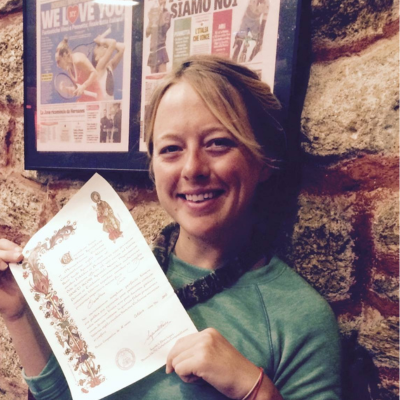
Written By
Liz Crouch
Liz, a New York native now in Melbourne, has over 11 years of international guiding experience on land and sea. Her expertise in active travel, especially for women, establishes her as a trusted authority on transformative adventures. RAW Travel clients benefit from Liz's expertise on trails like Camino Frances, Camino del Norte and Chemin du Le Puy.

